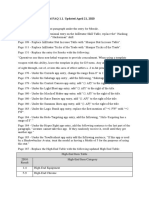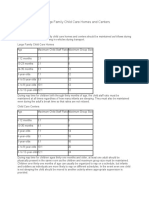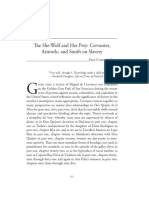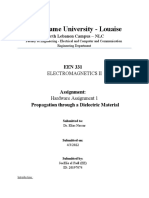Computer Science An Overview 9th Edition by Glenn Brookshear ISBN 0321387015 9780321387011 PDF Download
Uploaded by
brodergyaaseComputer Science An Overview 9th Edition by Glenn Brookshear ISBN 0321387015 9780321387011 PDF Download
Uploaded by
brodergyaaseComputer Science An Overview 9th Edition by
Glenn Brookshear ISBN 0321387015 9780321387011
pdf download
https://ebookball.com/product/computer-science-an-overview-9th-
edition-by-glenn-brookshear-isbn-0321387015-9780321387011-19818/
Explore and download more ebooks or textbooks
at ebookball.com
We have selected some products that you may be interested in
Click the link to download now or visit ebookball.com
for more options!.
Computer Science An Overview 9th Edition by Glenn
Brookshear ISBN 0321387015 9780321387011
https://ebookball.com/product/computer-science-an-overview-9th-
edition-by-glenn-brookshear-isbn-0321387015-9780321387011-19812/
Computer Science An Overview 11th Edition by Glenn
Brookshear ISBN 0132569035 9780132569033
https://ebookball.com/product/computer-science-an-overview-11th-
edition-by-glenn-brookshear-isbn-0132569035-9780132569033-9860/
Computer Science An Overview 1st Edition by Glenn
Brookshear ISBN 0805346325 9780805346329
https://ebookball.com/product/computer-science-an-overview-1st-
edition-by-glenn-brookshear-isbn-0805346325-9780805346329-8894/
Computer Security Art and Science 9th Edition by Matt
Bishop ISBN 0201440997 9780201440997
https://ebookball.com/product/computer-security-art-and-science-9th-
edition-by-matt-bishop-isbn-0201440997-9780201440997-19810/
Quantum Computer Science An Introduction 1st Edition by
David Mermin ISBN 0511339828 9780511339820
https://ebookball.com/product/quantum-computer-science-an-
introduction-1st-edition-by-david-mermin-
isbn-0511339828-9780511339820-19804/
Computer Science Press An Introduction to the Theory of
Computation 1st Edition by Eitan Gurari ISBN
https://ebookball.com/product/computer-science-press-an-introduction-
to-the-theory-of-computation-1st-edition-by-eitan-gurari-isbn-10804/
Computer Science and Compiler Design An Introduction with
C 1st Edition by Compiler Generators in C ISBN
https://ebookball.com/product/computer-science-and-compiler-design-an-
introduction-with-c-1st-edition-by-compiler-generators-in-c-
isbn-11720/
Synopsis of Oral and Maxillofacial Surgery An Update
Overview 1st Edition by Pradip Ghosh ISBN 8180616371
9788180616372
https://ebookball.com/product/synopsis-of-oral-and-maxillofacial-
surgery-an-update-overview-1st-edition-by-pradip-ghosh-
isbn-8180616371-9788180616372-7686/
Computer Science An Object Oriented Approach Using C 1st
edition by Behrouz Forouzan, Richard Gilberg 9780077418755
0077418751
https://ebookball.com/product/computer-science-an-object-oriented-
approach-using-c-1st-edition-by-behrouz-forouzan-richard-
gilberg-9780077418755-0077418751-15228/
fil.,l " '"T-'" -r-J .0' --- .- .) ... .' ,.,..
..
-: "
',;t " ..
I-
. ..;. ,,"'''
. , it. ' it >
' :_
,-
Pearson International Edition
J. Glenn Brookshear
,
Computer Science
An Overview NINTH EDITION
Computer Sc i en ce An Overview
9TH EDITION
I..
,\\
'/
Computer Sci ence An Overview
J. Glenn Brookshear
A ... PEARSON
"
Addison Wesley
Boston San Francisc New York ) LondO! Toronto Sydney Tokyo
Singapore Madrid Mexico C'ity '4nicb Paris Cape Town Hong Kong
Momreal
--
-
publisher: Greg Tobm Senior Acquisitions Editor: Michael Hirsch
Editorial Assistant: Lindsey 'Itiebel Text Designer: Gillian Hall, The
Aardvark Group Cover Design Supervisor: Joyce Cosentino Wells
Cover Designer: Night & Day Digital Assets Manager: Marianne Groth
Media Producer: Bethany Tidd Marketing Manager: Michelle Brown
Marketing Assistant: Dana Lopreato Senior Prepress Supervisor:
Caroline Fell Project Management: Keith Henry/Dartmouth
Publishing, Inc. Composition and Illustrations: Dartmouth Publishing,
Inc. Cover image: @ 2005 David Philips
If you purchased this book within the United States or Canada you
should be aware that it has been wrongfully imported without the
approval of the Publisher or the Author
Many of the designations used by manufacturers and sellers to
distinguish their products are claimed as trademarks. Where those
designations appear in this book, and Addison- Wesley was aware of
a trademark claim, the designations have been printed in initial caps
or all caps.
Copyright @ 2007 Pearson Education, Inc. All rights reserved. No
part ofthis publica- tion may be reproduced, stored in a retrieval
system, or transmitted, in any form or by any means, electronic,
mechanical, photocopying, recording, or otherwise, with- out the
prior written permission of the publisher. Printed in the United States
of Amer- ica. For information on obtaining permission for use of
material in this work, please submit a written request to Pearson
Education, Inc., Rights and Contracts Depart- ment, 75 Arlington
Street, Suite 300, Boston, MA 02116, fax your request to 617-848-
7047, or e-mail at
http://www.pearsoned.com/legal/permissions.htm.
ISBN 0-321-43445-5
1 23456789 1O-EB-09 08 07
To my parents Garland and Reba Brookshear
Q) () o
Q)
Q.
This book presents an introductory survey of computer science. It
explores the breadth of the subject while including enough depth to
convey an honest appreciation for the topics involved.
Audience
I wrote this text for students of computer science as well as students
from other dis- ciplines. As for computer science students, most
begin their studies with the illusion that computer science is
programming and Web browsing since that is essentially all they
have seen. Yet computer science is much more than this. In turn,
beginning computer science students need exposure to the breadth
of the subject in which they are planning to major. Providing this
exposure is the theme of this book. It gives stu- dents an overview
of computer science-a foundation from which they can appreci- ate
the relevance and interrelationships of future courses in the field.
This survey approach is, in fact, the model used for introductory
courses in the natural sciences. This broad background is also what
students from other disciplines need if they are to relate to the
technical society in which they live. A computer science course for
this audience should provide a practical, realistic understanding
ofthe entire field rather than merely an introduction to using the
Internet or training in the use of some popular software packages.
There is, of course, a proper place for training, but this text is about
educating. As the old Chinese proverb says: "Give a man a fish and
you feed him for a day. Teach a man to fish and you feed him for a
lifetime." Previous editions ofthis text have been used successfully in
courses for students over a wide range of disciplines and educational
levels, ranging from high school to graduate courses. This edition is
designed to continue that tradition.
New in the Ninth Edition
The most noteworthy changes reflected in this ninth edition are in
Chapter 4 (Net- working and the Internet), Chapter 7 (Software
Engineering), and Chapter 10 (Artifi- cial Intelligence). Although the
table of contents for these chapters has changed little, the material
inside has been expanded, updated, and rearranged significantly. In
Chapter 4 the coverage of networking fundamentals, XML and HTML,
and security
\\
8 Preface
has been expanded; Chapter 7 has been overhauled and now
includes a more precise introduction to UML; and Chapter 10 has
been extensively rewritten. Less dramatic changes in otller chapters
include the following: In Chapter 1, a sub- section on flash memory
devices has been added and the section on data compression has
been rewritten (LZ77 compression was replaced by LZW and
material on com- pressing audio and video was added). In Chapter
2, material on USB and FireWire has been added. In Chapter 3, the
introductory section as well as the section on secu- rity has been
rewritten. In Chapter 6, the subsection on linking and loading has
been deleted. In addition, many small changes have been made
throughout the text to pro- vide clear, up-to-date, and relevant
coverage of topics.
Organization
This text follows a bottom-up arrangement of subjects that
progresses from the con- crete to the abstract-an order that results
in a sound pedagogical presentation in which each topic leads to the
next. It begins with the fundamentals of information encoding and
computer architecture (Chapters 1 and 2), progresses to the study of
operating systems (Chapter 3) and computer networks (Chapter 4),
investigates the topics of algorithms, programming languages, and
software development (Chapters 5 through 7), explores issues of
data structures and databases (Chapters 8 and 9), con- siders future
applications of computer technology via artificial intelligence
(Chapter 10), and closes with an introduction to the theory of
computation (Chapter 11). Although the text follows this natural
progression, the individual chapters and sections are surprisingly
independent and can usually be read as isolated units or rearranged
to form alternative sequences of study. Indeed, the book is often
used as a text for courses that cover the material in a variety of
orders. One of these alterna- tives begins with material from
Chapters 5 and 6 (Algorithms and Programming Lan- guages) and
returns to the earlier chapters as desired. In contrast, I know of one
course that starts with the material on computability from Chapter
11. In still other instances the text has been used in "senior
capstone" courses where it serves as a backbone from which to
branch into projects in different areas. On the opening page of each
chapter, I have used asterisks to mark some sec- tions as optional.
These are sections that cover topics of more specific interest or per-
haps explore traditional topics in more depth. My intention is merely
to provide suggestions for those looking for alternative paths
through the text. There are, of course, other shortcuts. In particular,
if you are looking for a quick read, I suggest the following sequence:
Section 1.1-1.4 2.1-2.3 3.1-3.3 4.1-4.3
'Ibpic Basics of data encoding and storage Machine architecture and
machine language Operating systems Networking and the Internet
5.1-5.4 6.1-6.4 7.1-7.2 8.1-8.2 9.1-9.2 10.1-10.3 11.1-11.2
Algorithms and algorithm design Programming languages Software
engineering Data abstractions Database systems Artificial
intelligence Theory of computation
There are several themes woven throughout the text. One is that
computer sci- ence is dynamic. The text repeatedly presents topics
in a historical perspective, dis- cusses the current state of affairs,
and indicates directions of research. Another theme is the role of
abstraction and the way in which abstract tools are used to control
com- plexity. This theme is introduced in Chapter 0 and then echoed
in the context of oper- ating system architecture, algorithm
development, programming language design, software engineering,
data representation, and database systems.
To Instructors
There is more material in this text than can normally be covered in a
single semes- ter, so do not hesitate to skip topics that do not fit
your course objectives or to rearrange the order as you see fit. You
will find that, although the text follows a plot, the topics are covered
in a largely independent manner that allows you to pick and choose
as you desire. I wrote the book to be used as a course resource-not
as a course defini- tion. I myself like to cover some topics as reading
assignments and to encourage stu- dents to read the material not
explicitly included in my course. I think we underrate students if we
assume that we have to explain everything in class. We should be
help- ing them learn to learn on their own. I feel obliged to say a
few words about the bottom-up, concrete-to-abstract organ- ization
of the text. I think as academics we too often assume that students
will appre- ciate our perspective of a subject-often one that we have
developed over many years of working in a field. As teachers I think
we do better by presenting material from the student's perspective.
This is why the text starts with data representation/storage, machine
architecture, operating systems, and networking. These are topics to
which students readily relate-they have most likely heard terms such
as JPEG and MP3, they have probably recorded data on CDs and
DVDs, they have purchased computer components, they have
interacted with an operating system, and they have used the
Internet. By starting the course with these topics, I see my students
discovering answers to many of the "why" questions they have been
carrying for years and learn- ing to view the course as practical
rather than theoretical. From this beginning it is natural to move on
to the more abstract issues of algorithms, algOlithmic structures,
programming languages, software development methodologies,
computability, and complexity, which those of us in the field view as
the main topics in the science. As I've said before, the topics are
presented in a manner that does not force you to fol- low this
sequence, but I encourage you to give it a try.
Tolnsuuctors 9
Preface
We are all aware that students learn a lot more than we teach them
directly, and the lessons they learn implicitly are often better
absorbed than those that are stud- ied explicitly. This is significant
when it comes to "teaching" problem solving. Stu- dents do not
become problem solvers by studying problem-solving methodologies.
They become problem solvers by solving problems-and not just
carefully posed "text- book problems." So I have included numerous
problems throughout the text, a few of which are intentionally
vague-meaning that there is not a single correct answer. I encourage
you to use these and to expand on them. Another topic that I place
in this "implicit learning" category is that of profes- sionalism, ethics,
and social responsibility. I do not believe that this material should be
presented as an isolated subject. Instead, it should surface when it
is relevant, which is the approach I have taken in this text. You will
find that Sections 3.5, 4.5, 7.8,9.7, and 10.7 present such topics as
security, privacy, liability, and social aware- ness in the context of
operating systems, networking, database systems, software
engineering, and artificial intelligence. Moreover, Section 0.6
introduces this theme by summarizing some of the more prominent
theories that attempt to place ethical decision making on a
philosophically firm foundation. You will also find that each chapter
includes a collection of questions called Social Issues that challenge
students to think about the relationship between the material in the
text and the society in which they live. Thank you for considering my
text for your course. Whether you do or do not decide that it is right
for your situation, I hope that you find it to be a contribution to the
computer science education literature.
Pedagogical Features
This text is the product of many years of teaching. As a result, it is
rich in pedagogi- cal aids. Paramount is the abundance of problems
to enhance the student's partici- pation-over 1,000 in this ninth
edition. These are classified as Q],iestions & Exercises, Chapter
Review Problems, and Social Issues. The Questions & Exercises
appear at the end of each section (except for the introductory
chapter). They review the material just discussed, extend the
previous discussion, or hint at related topics to be covered later.
These questions are answered in Appendix F. The Chapter Review
Problems appear at the end of each chapter (except for the
introductory chapter). They are designed to serve as "homework"
problems in that they cover the material from the entire chapter and
are not answered in the text. Also at the end of each chapter are
questions in the Social Issues category. They are designed for
thought and discussion. Many of them can be used to launch
research assignments culminating in short written or oral reports.
Each chapter also ends with a list called Additional Reading that
contains references to other materials relating to the subject of the
chapter. The web sites identified in this preface, in the text, and in
the sidebars of the text are also good places to look for related
material.
Supplemental Resources
A variety of supplemental materials for this text are available at the
book's compan- ion website: www.aw . eom/brookshear. The
following are accessible to all readers: . Chapter-by-chapter activities
that extend topics in the text and provide oppor- tunities to explore
related topics; . Software simulators for the example machine used
throughout Chapter 2; and . Chapter-by-chapter "self tests" that
help readers to rethink the material covered in the text
In addition, the following supplements are available to qualified
instructors at Addison-Wesley's Instructor's Resource Center. please
visit www.aw . eom/ ire or con- tact your Addison-Wesley sales
representative for information on how to access them: . Instructor's
Guide with answers to the Chapter Review Problems; . Power Point
lecture slides; and . Test bank
You may also want to check out my personal website at
www.mses.mu . edu/ -g lennb. It is not very formal (and it is subject
to my whims and sense of humor) , but I tend to keep some
infurmation there that you may find helpful.
To Students
I'm a bit of a nonconformist (some of my friends would say more
than a bit) so when I set om to write this text I didn't always follow
the advice I received. In particular, many argued that certain
material was too advanced for beginning students. But I believe that
if a topic is relevant, then it is relevant even if the academic
community considers it to be an "advanced topic." You deserve a
text that presents a complete picture of computer science-not a
watered-down version containing artificially sim- plified presentations
of only those topics that have been deemed appropriate for intro-
ductory students. Thus, I have not avoided topics. Instead I've
sought better explanations. I've tried to provide enough depth to
give you an honest picture of what computer science is all about. As
in the case of spices in a recipe, you may choose to skip some of the
topics in the following pages, but they are there for you to taste if
you wish-and I encourage you to do so. I should also point out that
in any course dealing with technology, the details you leam today
may not be the details you will need to know tomorrow. The field is
dynamic- that's part of the excitement. This book will give you a
current picture of the subject as well as a historical perspective. With
this background you will be pre- pared to grow along with
technology. I encourage you to start the growing process now by
exploring beyond this text. Leam to leam. Thank you for the trust
you have placed in me by choosing to read my book. As an author I
have an obligation to produce a manuscript that is wortll your time.
1 hope you find that I have lived up to this obligation.
To Students 11
12 Preface
Acknowledgments
I first thank those of you who have supported this book by reading
and using it in pre- vious editions. I am honored. With each new
edition, the list of those who have contributed to the book as
reviewers and consultants grows. Today this list includes J. M.
Adams, C. M. Allen, D. C. S. Allison, R. Ashmore, B. Auernheimer, P.
Bankston, M. Barnard, P. Bender, K. Bowyer, P. W. Brashear, C. M.
Brown, B. Calloni, M. Clancy, R. T. Close, D. H. Cooley, L. D. Cornell,
M. J. Crowley, F. Deek, M. Dickerson, M. J. Duncan, S. Fox, N. E.
Gibbs, J. D. Harris, D. Hascom, L. Heath, P. B. Henderson, L. Hunt,
M. Hutchenreuther, L. A. Jehn, K. K. Kolberg, K. Korb, G. Krenz, J.
Liu, T. J. Long, C. May, W. McCown, S. J. Merrill, K. Messersmith, J.
C. Moyer, M. Murphy, J. P. Myers, Jr., D. S. Noonan, S. Olariu, G.
Rice, N. Rickert, C. Riedesel, J. B. Rogers, G. Saito, W. Savitch, R.
Schlafly, J. C. Schlimmer, S. Sells, G. Sheppard, Z. Shen, J. C. Simms,
M. C. Slattery, J. Slim- ick, J. A. Slomka, D. Smith, J. Solderitsch, R.
Steigerwald, L. Steinberg, C. A. Struble, C. L. Struble, W. J. Thffe, J.
Thlburt, P. Tonellato, P Tromovitch, E. D. Winter, E. Wright, M.
Ziegler, and one anonymous. To these individuals I give my sincere
thanks. A special thank you goes to Roger Eastman who played a
significant role in the rewrite of Chapter 10 (Artificial Intelligence). I
think you will find that his input has produced a significantly better
presentation of the subject. Roger is also the source of much ofthe
supporting materials at the text's website. I greatly appreciate his
efforts. I also thank the people at Addison-Wesley who have
contributed to this project. They are a great bunch to work with-and
good friends as well. If you are thinking about writing a textbook,
you should consider having it published by Addison-Wesley. I
continue to be grateful to my wife Earlene and daughter Cheryl who
have been tremendous sources of encouragement over the years.
Cheryl, of course, grew up and left home several years ago. But
Earlene is still here. I'm a lucky man. On the morn- ing of December
11, 1998, I survived a heart attack because she got me to the hospi-
tal in time. (For those of you in the younger generation I should
explain that surviving a heart attack is sort oflike getting an
extension on a homework assignment.) Finally, I tllank my parents,
to whom this book is dedicated. I close with the fol- lowing
endorsement whose source shall remain anonymous: "Our son's
book is really good. Everyone should read it."
J. G. B.
Random documents with unrelated
content Scribd suggests to you:
Section 4. Information about Donations to
the Project Gutenberg Literary Archive
Foundation
Project Gutenberg™ depends upon and cannot survive without
widespread public support and donations to carry out its mission
of increasing the number of public domain and licensed works
that can be freely distributed in machine-readable form
accessible by the widest array of equipment including outdated
equipment. Many small donations ($1 to $5,000) are particularly
important to maintaining tax exempt status with the IRS.
The Foundation is committed to complying with the laws
regulating charities and charitable donations in all 50 states of
the United States. Compliance requirements are not uniform
and it takes a considerable effort, much paperwork and many
fees to meet and keep up with these requirements. We do not
solicit donations in locations where we have not received written
confirmation of compliance. To SEND DONATIONS or determine
the status of compliance for any particular state visit
www.gutenberg.org/donate.
While we cannot and do not solicit contributions from states
where we have not met the solicitation requirements, we know
of no prohibition against accepting unsolicited donations from
donors in such states who approach us with offers to donate.
International donations are gratefully accepted, but we cannot
make any statements concerning tax treatment of donations
received from outside the United States. U.S. laws alone swamp
our small staff.
Please check the Project Gutenberg web pages for current
donation methods and addresses. Donations are accepted in a
number of other ways including checks, online payments and
credit card donations. To donate, please visit:
www.gutenberg.org/donate.
Section 5. General Information About
Project Gutenberg™ electronic works
Professor Michael S. Hart was the originator of the Project
Gutenberg™ concept of a library of electronic works that could
be freely shared with anyone. For forty years, he produced and
distributed Project Gutenberg™ eBooks with only a loose
network of volunteer support.
Project Gutenberg™ eBooks are often created from several
printed editions, all of which are confirmed as not protected by
copyright in the U.S. unless a copyright notice is included. Thus,
we do not necessarily keep eBooks in compliance with any
particular paper edition.
Most people start at our website which has the main PG search
facility: www.gutenberg.org.
This website includes information about Project Gutenberg™,
including how to make donations to the Project Gutenberg
Literary Archive Foundation, how to help produce our new
eBooks, and how to subscribe to our email newsletter to hear
about new eBooks.
Welcome to our website – the ideal destination for book lovers and
knowledge seekers. With a mission to inspire endlessly, we offer a
vast collection of books, ranging from classic literary works to
specialized publications, self-development books, and children's
literature. Each book is a new journey of discovery, expanding
knowledge and enriching the soul of the reade
Our website is not just a platform for buying books, but a bridge
connecting readers to the timeless values of culture and wisdom. With
an elegant, user-friendly interface and an intelligent search system,
we are committed to providing a quick and convenient shopping
experience. Additionally, our special promotions and home delivery
services ensure that you save time and fully enjoy the joy of reading.
Let us accompany you on the journey of exploring knowledge and
personal growth!
ebookball.com
You might also like
- Sparkman, Robert - Real Chemistry Experiments - Great and Fun Chemistry Experiments For Kids (2020)No ratings yetSparkman, Robert - Real Chemistry Experiments - Great and Fun Chemistry Experiments For Kids (2020)49 pages
- UNIT-3 Decision Control and Looping Statements. Arrays Final123No ratings yetUNIT-3 Decision Control and Looping Statements. Arrays Final12377 pages
- Knitting Machine Operation Manual FINISHEDNo ratings yetKnitting Machine Operation Manual FINISHED37 pages
- ΘΕΜΑΤΑ ΑΓΓΛΙΚΩΝ Β ΤΑΞΗΣ (ΠΡΟΧΩΡΗΜΕΝΩΝ) ΓΥΜΝΑΣΙΟΥ ΜΑΡΑΘΩΝΑ ΙΟΥΝΙΟΥ 2012.0% (3)ΘΕΜΑΤΑ ΑΓΓΛΙΚΩΝ Β ΤΑΞΗΣ (ΠΡΟΧΩΡΗΜΕΝΩΝ) ΓΥΜΝΑΣΙΟΥ ΜΑΡΑΘΩΝΑ ΙΟΥΝΙΟΥ 2012.2 pages
- 1st Quarter Exam Introduction To The Philosophy of The Human Person100% (1)1st Quarter Exam Introduction To The Philosophy of The Human Person2 pages
- Multiple Choice Questions and Answers On FET - Electronics Post PDF0% (1)Multiple Choice Questions and Answers On FET - Electronics Post PDF24 pages
- International Case Competition at Harvard (Case Brief) PDFNo ratings yetInternational Case Competition at Harvard (Case Brief) PDF10 pages
- Mathematics Maths NSC P1 QP Sept 2024 North WestNo ratings yetMathematics Maths NSC P1 QP Sept 2024 North West11 pages
- Circular 20231230151930 Holiday HomeworkNo ratings yetCircular 20231230151930 Holiday Homework12 pages
- The Smiths Supplier Code of Business EthicsNo ratings yetThe Smiths Supplier Code of Business Ethics6 pages
- Dental Codes Auth Requirement - DCDT DNE 2nd July 2020No ratings yetDental Codes Auth Requirement - DCDT DNE 2nd July 202028 pages
- Understand The Concepts of The Topic Actively Participate in Class Discussion and Formulate Significance of The StudyNo ratings yetUnderstand The Concepts of The Topic Actively Participate in Class Discussion and Formulate Significance of The Study2 pages





























